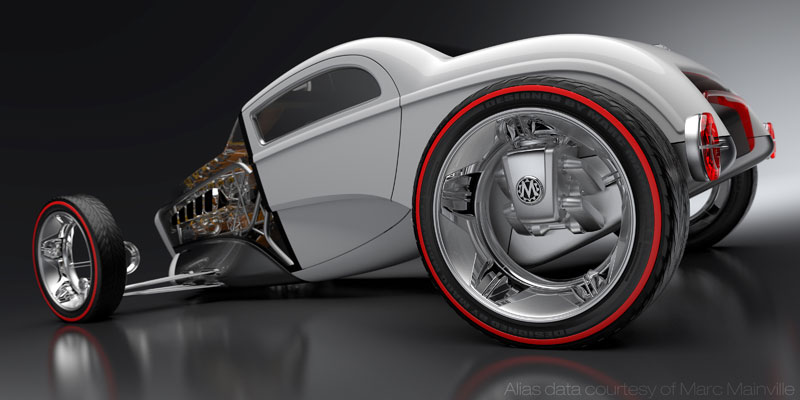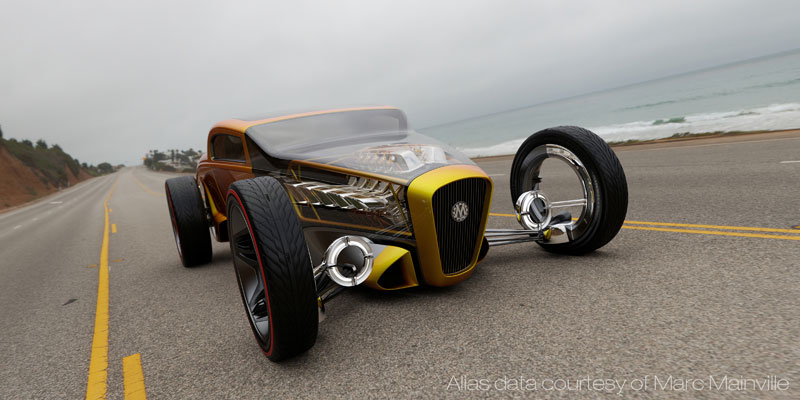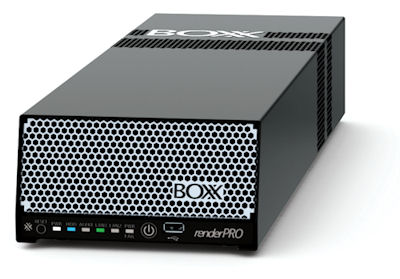Render on the Go with VRED and renderPRO

“Hyper Rod” created by Marc Mainville in Autodesk Alias. Rendered by James Cronin in VRED.
Latest News
March 29, 2014
p>
James Cronin originally learned Alias at Detroit’s College For Creative Studies, way back when it was still “Alias Wavefront.” He’s worked for General Motors, Alias and Nissan Design America (where he was a concept modeler and visualization lead).
After more than a decade on the West Coast, Cronin decided it was time to return to Michigan. Friends told him of an opening for a “Subject Matter Expert in Automotive Design” at Autodesk, and it was a perfect fit.
“There’s a big auto design presence here, and they need someone local,” says Cronin. “I go around to customers and show them Autodesk’s automotive design tools.”
Those tools were mainly Alias, Sketchbook and Showcase until Autodesk acquired PI-VR, makers of the VRED ray-tracing software. Cronin promptly added VRED to his arsenal. In fact, with the exception of some “what’s new” demos when a new version of Alias ships, VRED is just about all Cronin’s using these days.
Auto Visualization
Autodesk bills VRED as “visualization software,” but it’s what we used to call a ray tracing application. VRED is similar in concept to products like Bunkspeed and Keyshot, in that it produces very high quality renders, quickly and with a minimum of fuss. VRED doesn’t create geometry; all your models come in from other software.
It doesn’t do complex animations, physics or particle effects, although you can import animations from other applications, such as Maya. Controls and options are relatively simple. As a result, says Cronin, “VRED training is usually just two days. That’s it, and people are up to speed. It’s a pretty straightforward, easy-to-use piece of software.”
That’s good, because more and more designers are finding that visualization is becoming a part of their job.
“You’re seeing visualization entering every single aspect of automotive manufacturing and design,” says Cronin. “That’s part of the reason that Autodesk acquired VRED. VRED is very horizontally positioned. It can be in lots of groups, and those groups can share assets instead of re-inventing your rendering for every stage. You can get your data in here quickly and make a nice rendering; you can bring in full production data sets and do analysis of gaps; and then you can do your marketing level imagery, all in one tool.”
VRED does come in several flavors—Standard, Design, Professional and Presenter—depending on your particular needs. Do you need to analyze surface shape and continuity? Or just render simple objects with realistic materials?
Signature Lighting
One of the advantages of ray tracing in general is the ability to do accurate simulations of light as it bends and bounces off of, between and through materials. VRED can do advanced, accurate light visualization, which is crucial to an increasingly important area of automotive design: signature lighting.
“These days,” says Cronin, “when cars are coming toward you, it’s not just the headlights you see, it’s the signature lighting elements. When you’re behind a Volvo at night, you know it’s a Volvo. BMW has those ‘angel eyes.’ Even the new Ford F150 truck has signature lighting.
“A lot of design studios are taking traditional designers and saying, ‘You’re going to be our specialist in automotive lighting design,’” he continues. “That’s where VRED and its ability to do high-end lighting simulation is becoming important for the standard designer.”
Traditionally, the way to visualize a headlight is to build a physical prototype. But those prototypes—typically 3D printed via stereolithography (SLA), then sanded, chrome plated and capped with a nice vacuum-formed lens—can cost a design studio up to $40,000 per part. Add in a prototype taillight, revise a time or two, and multiply by however many designs a company might do every year—and it adds up rather quickly.
“If you can do some digital prototyping inside of VRED,” says Cronin, “you’re going to pay for the software in one project. The cost of the software and hardware is minor compared to spending $40,000 per light. It’s cheap to do these things upstream.”
Thanks to constantly increasing computer power, more and more “upstream” designers have access to powerful visualization tools. “My laptop’s more powerful than my workstation was 3 years ago,” Cronin points out. And speaking of laptops …
Laptops vs. Workstations
Cronin notes that everyone in his role—Autodesk Technical Account Managers or Subject Matter Experts—has a laptop. Portable by design, they’re the perfect machines to take to clients for software demos. Cronin can still recall a time when demoing Alias software involved hauling an entire workstation and its accompanying fat CRT monitor around from client to client.
But laptops also have a key problem: While today’s models may be as powerful as yesterday’s workstation, they are in not as powerful as today’s workstations, and a high-end ray-tracing program like VRED wants all the fast RAM and CPU cycles it can get. That’s especially true if you’re visualizing the fiddly bits inside a car’s headlight assembly, for example.
Yet workstations, with their giant power supplies and multiple graphics cards, are just as heavy as ever—and just as impractical to lug around. Enter the BOXX Technologies renderPRO into Cronin’s life.
Packs a Punch
As a minimalist box designed to sit nicely atop your desktop workstation—6.75x20x3.8 in.—the renderPRO packs a choice of dual Xeon processors, a solid-state drive (SSD) and up to 128GB of DDR3 RAM. Depending on your loadout, it will run you from $3,200 for the basic configuration to $13,000 and change for a high-end package. Use an Ethernet cable to plug it into a PC or laptop running a cluster-capable application such as VRED, and it’s like having a miniature render farm in an oversized shoebox.
“That is why I got it,” says Cronin. “When I’m in front of a customer and I’m tumbling the model, that little bitty renderPRO is doing all the work. I’m demoing on my laptop, but I’ve got the power of a workstation.”
Need more power? Add another renderPRO. “I could have five renderPROs, and VRED would use all of them,” says Cronin. “That’s one reason that I demo VRED’s clustering. A lot of our customers already have a large render farm available. It sparks ideas.”
Our expectations evolve concurrently with software and hardware. “Ten years ago,” says Cronin, “they were happy if you had something that looked like a video game. Now they want something that looks like a photograph. And when you rotate it, they don’t want to sit and watch the ray tracing happen. They want it to be instant.
 The BOXX Technologies renderPRO, packed in its case and ready for air travel. Image courtesy of James Cronin.
The BOXX Technologies renderPRO, packed in its case and ready for air travel. Image courtesy of James Cronin.“[The renderPRO] alleviates those long dramatic pauses in demos when you’re waiting for your little laptop to do a bunch of work, wishing you’d brought your workstation,” he adds.
VRED plus the renderPRO yields near real-time performance, even with very demanding renders. “That’s important when you’re demoing headlights,” says Cronin. “People get bored very quickly. You don’t want them looking at a view that’s gritty and noisy and slowwwwly calculating those bounces.”
Travel Companion
As important as its speed, says Cronin, is the renderPRO’s petite size: “The renderPRO is the perfect size for travel.” He packs both his laptop and the renderPRO in a rolling hard case, which fits nicely into the overhead bins on airplanes. More than convenient, this is absolutely crucial, he says.
“I can’t have something that goes under the plane,” he explains. “I’m sure the luggage handlers are all very careful with everything, but the expense and the importance of the hardware I’m taking on demos, or to trade shows, means that I need something I can carry on.”
In fact, Cronin doesn’t bother with small test renders these days. He renders everything at 4000x2000—print resolution—right from the start. He trusts the renderPRO and VRED to produce a final render on his laptop before he gets bored.
Cronin has a conventional, desktop workstation, but says he rarely uses it. “Last night, I did a render on [my laptop and renderPRO] that was 34,000 by 18,000 pixels. They want to make a wall poster of one of my renderings, so I needed a render that was a gigantic resolution, but I didn’t need a gigantic workstation.
“The renderPRO is like my own little one-machine render farm,” he concludes “I can add my laptop into the processing power if I want those eight extra virtual cores. But if I just render on the renderPRO, then I can keep working, answering emails and surfing the web on my laptop, while the renderPRO is doing all the work.”
More Info
Subscribe to our FREE magazine, FREE email newsletters or both!
Latest News
About the Author
Mark ClarksonContributing Editor Mark Clarkson is Digital Engineering’s expert in visualization, computer animation, and graphics. His newest book is Photoshop Elements by Example. Visit him on the web at MarkClarkson.com or send e-mail about this article to [email protected].
Follow DE








